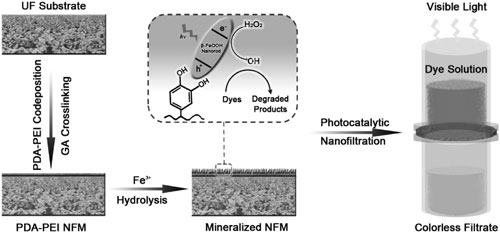| Posted: May 18, 2017 | |
Self-cleaning photocatalytic nanomembranes for water filtration(Nanowerk News) Compared with traditional treatment methods including absorption, coagulation, oxidation, and biodegradation, membrane technology has potential as an efficient and green strategy to purify sewage because of its high removal efficiency for color and chemical oxygen demand. |
|
| Given the high retention rate for low-molecularweight organics (200–1000 Da) and low energy consumption, nanofiltration membranes (NFMs) have drawn attention for advanced textile wastewater treatment. | |
| However, NFMs often suffer from membrane fouling driven in large part by adsorption of organic pollutants on membrane surfaces through electrostatic attraction, hydrophobic forces, and other strong interactions. | |
| A direct consequence of membrane fouling is performance degradation and decreased membrane lifespan. | |
| Researchers in China have reported (Advanced Functional Materials, "Photocatalytic Nanofiltration Membranes with Self-Cleaning Property for Wastewater Treatment") a robust strategy to mineralize various polymeric membranes with enhanced curling resistance and surface wettability via mussel-inspired PDA/polyethyleneimine (PEI) intermediate layers. | |
 |
|
| Schematic representation of preparation process for the Β–FeOOH mineralized NFM and its application in photocatalytic nanofiltration. (© Wiley-VCH Verlag) (click on image to enlarge) | |
| Compared with a simple PDA layer, the PDA/PEI intermediate layer was thinner, smoother, and more stable, and could also work as a defect-free selective nanofiltration layer for water purification. | |
| The photocatalytic layer consisting of β-FeOOH nanorods shows high photo-Fenton reaction activity under visible light irradiation in the presence of H2O2, endowing the membranes with steady separation performance, photocatalytic antifouling, and self-cleaning functions. | |
| Moreover, the layer exhibits good stability during cyclic photocatalytic filtration owing to the strong coordination complex between the PDA–PEI layer and β-FeOOH nanorods. | |
| "We believe this strategy broadens the territory for potential application of these multifunctional NFMs in wastewater treatment, and also provides new insight into combining filtration and other functions in membrane technology for next-generation multifunctional membrane separation processes," the authors conclude. |
 By
Michael
Berger
– Michael is author of three books by the Royal Society of Chemistry:
Nano-Society: Pushing the Boundaries of Technology,
Nanotechnology: The Future is Tiny, and
Nanoengineering: The Skills and Tools Making Technology Invisible
Copyright ©
Nanowerk LLC
By
Michael
Berger
– Michael is author of three books by the Royal Society of Chemistry:
Nano-Society: Pushing the Boundaries of Technology,
Nanotechnology: The Future is Tiny, and
Nanoengineering: The Skills and Tools Making Technology Invisible
Copyright ©
Nanowerk LLC
|
|
|
Subscribe to a free copy of one of our daily Nanowerk Newsletter Email Digests with a compilation of all of the day's news. |
